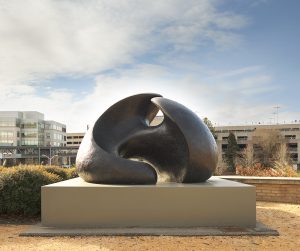CLOSE LOOKS: "NEXT GENERATION II" BY ALLAN C. HOUSER
I see an embrace. A mother, wearing a blanket wrapped around her shoulders, extends her arms out to envelop her little one in warmth and comfort. The little one’s arms reach high—in need, in excitement, in aching relief—to clasp her neck. Joined, they are two halves made whole. They are their own and yet, also each other’s. I see the nurturing, strong Native women in paintings and sketches my own mother collects on her walls at home, and in the many exhibits she took me and my sister to view growing up. I see lines and light and artistry I would not be able to see without the guidance she shared all those afternoons we spent together in the galleries of D.C.
- Marissa Carmi (Oneida Nation of Wisconsin) is the Associate Director of the American Indian Center and PhD candidate in American Indian and Indigenous Studies at UNC-Chapel Hill.

Allan C. Houser, Chiricahua Apache, 1914-1994, Next Generation II, 1989, bronze, sculpture: 61 x 92 x 74 in., 1500 lb. (154.9 x 233.7 x 188 cm, 680.39554 kg). Gift of Hugh A. McAllister Jr., MD ’66 in honor of his father Hugh A. McAllister Sr., MD ’35, 2012.3. © Chiinde LLC (a Houser/ Haozous family corporation).
Art asks us to pause, to breathe, to look, to ponder and then, to walk away holding a memory, however fleeting, of a moment in which the world grew still. This happens in the galleries at the Ackland Art Museum every day. I have seen it. But I have also seen this mystery with what is called public art. Public art is set into the wider world, with the context of changing light and shadow, sound and silence. Nevertheless, a stillness comes if we will pause.
Next Generation II is a remarkably quiet work of art. The scale is human – five feet, one inch tall and only a little more than eight feet wide. It is solid, sturdy, and impermeable. Without a “front” or a “back,” the sculpture holds time and space in three dimensions, and then, perhaps there is the suggestion of another dimension, the passage of time. Maybe this is why its placement near the entrance to the UNC Hospitals is so poignant. Unmoved by the reason you must enter or leave the hospital, it offers a moment of reflection. Pause and ask: Am I the next generation? Are you? Will the hospital be the last place I see? Is this the beginning or the end? Am I holding on or being held? We are all somewhere in the middle, taking a pause and in that moment, waiting with anticipation for what will come next.
- Amanda Millay Hughes is the senior director of development and strategy at Duke University Chapel. An artist and writer, Hughes spent many years at the Ackland as a staff member, docent, and participant in The Five Faiths Project. She leads the monthly Drawing in the Galleries program at the Ackland.
- What word first comes to mind when you view the sculpture? Whether the word is about an emotion, the shape of the sculpture, or the material it’s made with, name what you see that gives you that impression.
- Describe the forms that make up the sculpture. How would you characterize them individually? What is the nature of their relationship? What do you see that makes you think that?
- Where do you notice negative space, or the space between and around the object? How does this interact with the positive space of the artwork, or the solid form of the piece? How does this change as you move around the sculpture?
- Consider where the sculpture is installed. What effect does the location have on the sculpture? Consider the artwork’s material and title.
- Visit Allan C. Houser’s website to read about his life, view images of his artwork, and watch a virtual tour of the outdoor sculpture garden with his sculptures.
- Explore select works of art by Indigenous North American artists in the Ackland’s collection in Ackland Upstairs from January 10 through May 12, 2024. Pick up a self-guided tour on the F.A.M. Cart in the Ackland’s lobby that highlights these six artworks.
- Allan C. Houser was a Chiricahua Apache artist. Click here to view the Native Land Digital map, and click here to view and learn more about the Chiricahua Apache territory.
- Watch “The Dean of Stone,” a PBS special about Allan C. Houser that aired in 1992. See the artist at work and listen to him talk about his artistic process and sources of inspiration. This shorter video also includes the voices of Anna Maria Houser and Philip Haozous.
- Read a post on the Ackland’s website about the installation of Next Generation II at the UNC Hospitals complex and the 2011 exhibition of works that connected to the Houser sculpture.
- Click here for Google Maps directions to Next Generation II at the UNC Hospitals complex.
